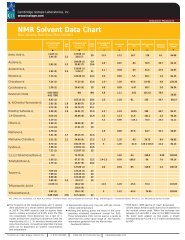Deuterated Solvents for NMR - Cambridge Isotope Laboratories
Deuterated Solvents for NMR - Cambridge Isotope Laboratories
Deuterated Solvents for NMR - Cambridge Isotope Laboratories
You also want an ePaper? Increase the reach of your titles
YUMPU automatically turns print PDFs into web optimized ePapers that Google loves.
<strong>Cambridge</strong> <strong>Isotope</strong> <strong>Laboratories</strong>, Inc. www.isotope.com<br />
<strong>NMR</strong> <strong>Solvents</strong><br />
<strong>NMR</strong> SOLVENT DATA ChART<br />
Acetic Acid-d 4<br />
Acetone-d 6<br />
<strong>Cambridge</strong> <strong>Isotope</strong> <strong>Laboratories</strong>, Inc.<br />
www.isotope.com<br />
<strong>NMR</strong> Solvent Data Chart<br />
More <strong>Solvents</strong>, More Sizes, More Solutions<br />
11.65 (1)<br />
2.04 (5) 2.2<br />
S Budavari, M.J. O’Neil, A. Smith, P.E. Heckelman, The Merck Index, an Encyclopedia of Chemicals, Drugs, and Biologicals - Eleventh Edition, Merck Co., Inc. Rahway, NJ, 1989.<br />
� The 1 H spectra of the residual protons and 13 C spectra<br />
were obtained on a Varian Gemini 200 spectrometer<br />
at 295°K. The <strong>NMR</strong> solvents used to acquire these<br />
spectra contain a maximum of 0.05% and 1.0% TMS<br />
(v/v) respectively. Since deuterium has a spin of 1,<br />
triplets arising from coupling to deuterium have the<br />
intensity ratio of 1:1:1. ‘m’ denotes a broad peak with<br />
some fine structures. It should be noted that chemical<br />
shifts can be dependent on solvent, concentration<br />
and temperature.<br />
1H Chemical Shift<br />
(ppm from TMS)<br />
(multiplicity)<br />
JCD(Hz)<br />
13C Chemical Shift<br />
(ppm from TMS)<br />
(multiplicity)<br />
� �<br />
178.99 (1)<br />
20.0 (7)<br />
206.68 (1)<br />
29.92 (7)<br />
JCD(Hz)<br />
� Approximate values only, may vary with pH, concentration<br />
and temperature.<br />
� Melting and boiling points are those of the corresponding<br />
unlabeled compound (except <strong>for</strong> D 2O).<br />
These temperature limits can be used as a guide to<br />
determine the useful liquid range of the solvents.<br />
In<strong>for</strong>mation gathered from the Merck Index<br />
-Eleventh Edition.<br />
unit<br />
RESEARCH PRODUCTS<br />
20 11.5 1.12 16.7 118 6.1 64.08<br />
0.9<br />
19.4<br />
1H Chemical Shift<br />
of HOD<br />
(ppm from TMS)<br />
Density at<br />
20°C<br />
Melting point<br />
(°C)<br />
Boiling point<br />
(°C)<br />
� �<br />
� �<br />
Dielectric<br />
Constant<br />
2.05 (5) 2.2<br />
2.8 * 0.87 -94 56.5 20.7 64.12<br />
Acetonitrile-d3 1.94 (5) 2.5<br />
118.69 (1)<br />
1.39 (7) 21<br />
2.1 * 0.84 -45 81.6 37.5 44.07<br />
Benzene-d6 7.16 (1) 128.39 (3) 24.3 0.4 0.95 5.5 80.1 2.3 84.15<br />
Chloro<strong>for</strong>m-d 7.24 (1) 77.23 (3) 32.0 1.5 * 1.50 -63.5 61-62 4.8 120.38<br />
Cyclohexane-d 12 1.38 (1) 26.43 (5) 19 0.8 0.89 6.47 80.7 2.0 96.24<br />
Molecular<br />
Weight<br />
Deuterium Oxide<br />
4.80 (DSS)<br />
4.81 (TSP)<br />
NA NA 4.8 1.11 3.81 101.42 78.5<br />
20.03<br />
8.03 (1) 163.15 (3) 29.4 3.5 1.03 -61 153 36.7 80.14<br />
N, N-Dimethyl-<strong>for</strong>mamide-d7 2.92 (5) 1.9 34.89 (7) 21.0<br />
2.75 (5) 1.9 29.76 (7) 21.1<br />
Dimethyl Sulfoxide-d6 2.50 (5) 1.9 39.51 (7) 21.0 3.3 * 1.19 18.45 189 46.7 84.17<br />
1,4-Dioxane-d8 3.53 (m) 66.66 (5) 21.9 2.4 1.13 11.8 101.1 2.2 96.16<br />
5.19 (1) 5.3 0.89 -114.1 78.5 24.5 52.11<br />
Ethanol-d6 3.56 (1) 56.96 (5) 22<br />
1.11 (m) 17.31 (7) 19<br />
Methanol-d4 4.78 (1) 4.9 0.89 -97.8 64.7 32.7 36.07<br />
3.31 (5) 1.7 49.15 (7) 21.4<br />
Methylene Chloride-d2 5.32 (3) 1.1 54.00 (5) 27.2 1.5 1.35 -95 39.75 8.9 86.95<br />
8.74 (1) 150.35 (3) 27.5 5 1.05 -42 115-116 12.4 84.13<br />
Pyridine-d5 7.58 (1) 135.91 (3) 24.5<br />
7.22 (1) 123.87 (3) 25<br />
1,1,2,2-Tetrachloroethane-d2 6.0 73.78 (3) 1.62 -44 147 8.20 169.86<br />
Tetrahydrofuran-d8 3.58 (1)<br />
1.73 (1)<br />
67.57 (5)<br />
25.37 (5)<br />
22.2<br />
20.2<br />
2.4-2.5 0.99 -108.5 66 7.6 80.16<br />
137.86 (1) 0.4 0.94 -95 110.6 2.4 100.19<br />
Toluene-d8 7.09 (m)<br />
7.00 (1)<br />
129.24 (3)<br />
128.33 (3)<br />
23<br />
24<br />
6.98 (5) 125.49 (3) 24<br />
2.09 (5) 2.3 20.4 (7) 19<br />
Trifluoroacetic Acid-d<br />
11.50 (1) 164.2 (4)<br />
116.6 (4)<br />
11.5 1.41 -15.4 72.4 115.03<br />
Trifluoroethanol-d3 5.02 (1)<br />
3.88 (4x3) 2(9)<br />
126.3 (4)<br />
61.5 (4x5) 22<br />
5 1.41 -43.3 75 103.06<br />
To place an order please contact CIL: t: 978.749.8000 1.800.322.1174 (N.America) cilsales@isotope.com<br />
<strong>NMR</strong> SOLVENTS<br />
* HOD Peaks - <strong>NMR</strong> spectra of “neat” deuterated<br />
solvent always exhibit a peak due to H 20 in addition to<br />
the residual solvent peak. When the exchange rate<br />
between H 20 and HDO is slow on the <strong>NMR</strong> timescale<br />
the water peak appears as two peaks, a singlet<br />
corresponding to H 20 and a 1:1:1 triplet corresponding<br />
to HDO.<br />
tel: 978-749-8000 800-322-1174 (USA) fax: 978-749-2768 cilsales@isotope.com<br />
�<br />
20







